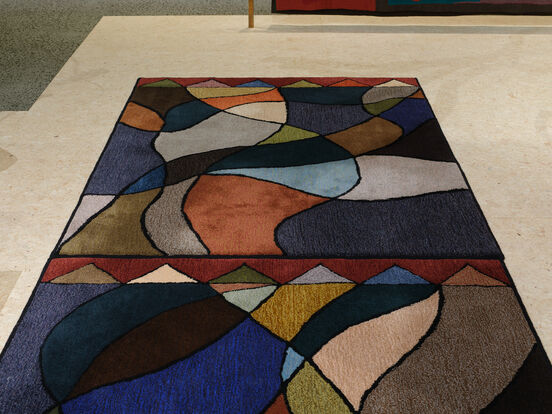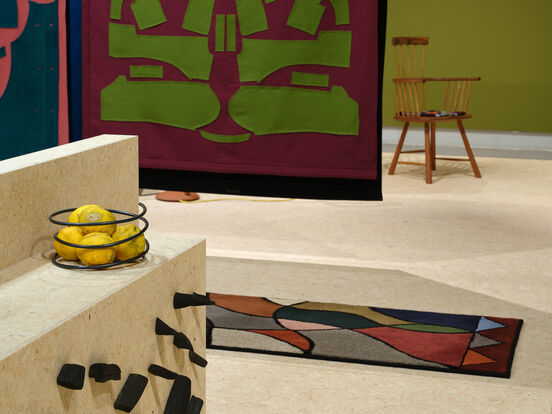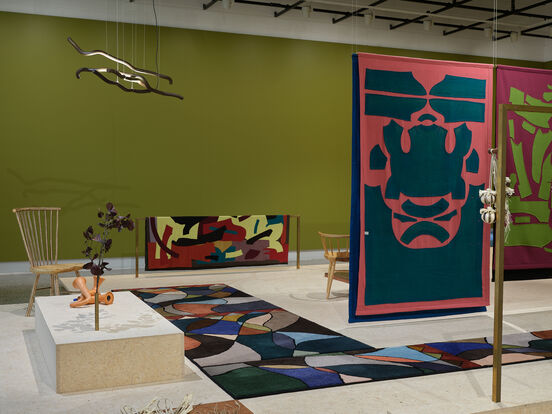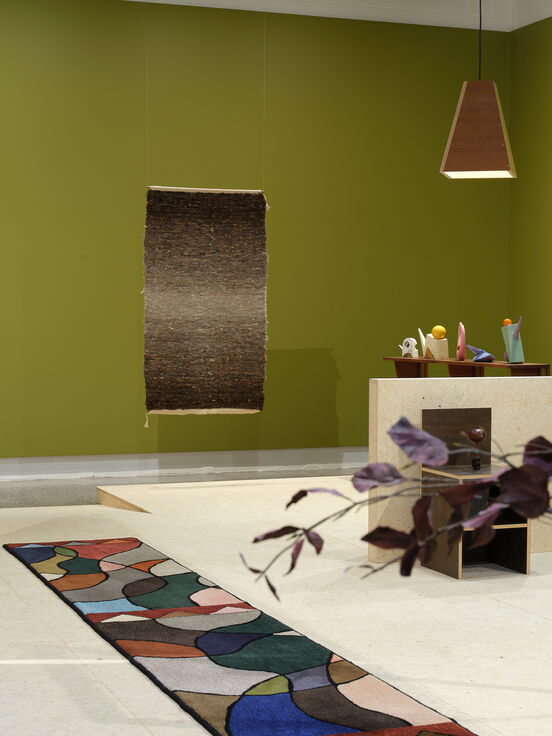How to make a home with… Megan Brady
Megan Brady is one of 14 artists, makers and designers exhibiting in How to make a home, a show exploring the small universe of home and the material politics of the objects and adornment we live with over time. We asked Megan four quick questions about their work in the exhibition and what makes a home, read her responses below.
—
Objectspace: Can you briefly describe the material and making of your works in How to make a home?
Megan Brady: These carpets have three layers: hand-tufted wool on the top surface, a primary woven fabric nestled in the middle, and a combination of latex and hessian underneath. All three of these layers are held together with a wool binding that wraps around the exterior of each piece.
When making these works, the woven fabric is stretched across a frame. With a tufting machine I begin drawing, with wool, imagery that is informed by my thinking at the time. Here, I am working vertically with the materials, kanohi ki te kanohi. I appreciate this mode of making as a form of relationship building with my works before they are laid down and engaged with in a more embodied way.
Making carpet is laborious and physical mahi, but it is a process I find a lot of satisfaction in. One of my favourite things about these works is how they function. The carpet pile is thick, soft and inviting. They have these visceral qualities that connect our bodies to the ground. And because the works are robust, they can accommodate all kinds of interactions – you can walk and wheel across them, or stretch out for a moment of rest, whatever feels right. Kids know how to activate them the best.
OS: Can you share some of your thinking behind the works?
MB: The carpets included in How to make a home are from a larger work I made in 2023 for Spring Time is Heart-break: Contemporary Art in Aotearoa at Christchurch Art Gallery Te Puna o Waiwhetū. They consider ideas of return, memory, first meetings and time in relation to ancestral sites.
Last year I relocated to Ōtautahi for six months to reconnect with and research my Ngāi Tūāhuriri whakapapa – this work was developed as a result of that time. Entangled and turning, we are river was specifically informed by meeting my ancestral awa Rakahuri, and observing the ways she draws herself across the whenua.
I came to think of the channels of the braided awa as pathways made by my tūpuna and myself across time and place; imagining what is transferred when we encounter one another through landscape.
Like a river, I am always seeking out a pathway to the ocean. Whether visualising a route when looking out a window, or engaging with an object that connects my memory to the moana. When I have access to the water, I am home. This is what aramoana means – pathway to the sea.
The recurring zigzag pattern in the work is inspired by aramoana tāniko whakairo and reminiscent of pinking shear edges in our family photo albums. These design gestures also mihi to Kā Tiritiri o te Moana / Southern Alps, the source of our awa as she journeys towards the sea.
OS: How do you feel your work connects to domestic spaces and/or the way we adorn and dress them?
MB: I feel like carpet connects to memories of domestic space (or at least my memories.) Here are a few that come to mind:
I remember hopping out of bed as a child and my feet landing on a latch hook rug my grandad made for me. I remember watching my parents unroll a new rug down our hallway and thinking how satisfying it was to witness. I remember laying on the carpet in the after-school sunshine, alongside our family cat. I remember sneaking into the lounge in early mornings, desperate to play. The carpet absorbing the sound of Lego as I tipped it onto the floor.
Reflections on carpet seem to remind me of being a child, which almost always locates me in my childhood home.
The materiality of this work connects to one dominant idea of the domestic. One that is safe, comforting and warm. I think of carpet as a brilliant domestic companion. It quietens footsteps, and softens spaces. It offers cushion and care beneath us as we move down a hallway or around a room. Carpets insulate, holding onto our heat. Carpets tell stories of where we spend the most time. The functionally of the work is home-friendly too, and your domesticated pet will quickly claim the rug as their own.
Conceptually, the work references connections within te taiao, evoking a deeper understanding of ideas of home. I feel the work in this iteration invites me to think about the many ways we can make a home, and how we can simultaneously locate feelings of belonging both inside and outside of the domestic space.
OS: How to make a home posits that what makes a home is the persistence of ‘things’ that inspire us to feel like we belong. Can you tell us about an object that has made, or does make, your home a home?
MB: One cherished object is a rimu shrink pot that sits upon on our bed head. I love rimu because of its old relationship to water. I was once told by a friend that across the islands the kupu 'limu’ refers to seaweed. It is said that when Māori first travelled to Aotearoa and saw the trees, their foliage reminded them of a type of seaweed, giving rimu its name. Through this pūrākau, being close to rimu keeps me close to the ocean.
This particular rimu is from my partner’s family home. The tree was planted the year he was born and it had to be removed as it was growing into the house. That year, I commissioned a friend to make the pot for my partner’s birthday. It is such a beautiful object. Slightly smaller than an aluminium can, it is a honey-coloured cylindrical container with a thick, dark walnut lid. It is the smoothest thing I have ever touched – I am often taken aback by this when I hold it in my hands. The rimu shrink pot has become a vessel for holding notes my partner and I have written to each other over the years. It’s an object that has become so at home in our home, that sometimes I forget it is there. But each time I see it, I know I am home too.
—
More about Megan Brady
Megan Brady (Kāi Tahu, Ngāi Tūāhuriri, Pākehā) is an artist based in Ōtepoti Dunedin. Working across sculpture, installation and sound, she is particularly interested in the way we navigate sites – often responding to patterns and details in the environment. Selected recent exhibitions include Spring Time is Heart-break: Contemporary Art in Aotearoa, Christchurch Art Gallery Te Puna Waiwhetū, 2023, At Home, Te Ara Ātea, 2023, Te Hā, The Physics Room, 2023, Paemanu: Tauraka Toi, Dunedin Public Art Gallery, 2021–2022; Lay in measures with Ed Ritchie, Enjoy Contemporary Art Space, 2020, and A quiet corner where we can talk, Dunedin Public Art Gallery, 2018.
Brady's work in How to make a home was made on residency at Te Matatiki Toi Ora The Arts Centre with support from Creative New Zealand and Christchurch Art Gallery Te Puna o Waiwhetū.




Megan Brady, Entangled and turning, we are river, 2023, within How to make a home, 14 Sep–17 Nov 2024 at Objectspace, photographs by Sam Hartnett